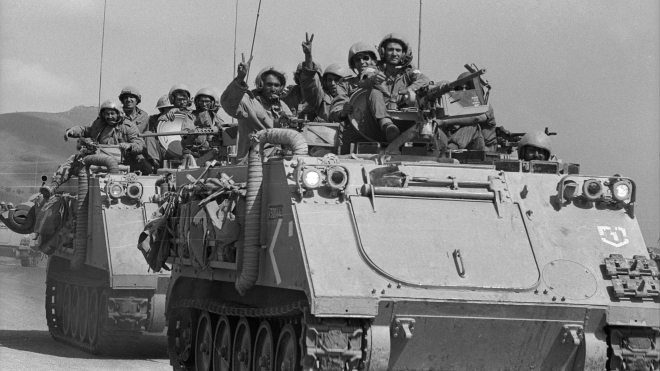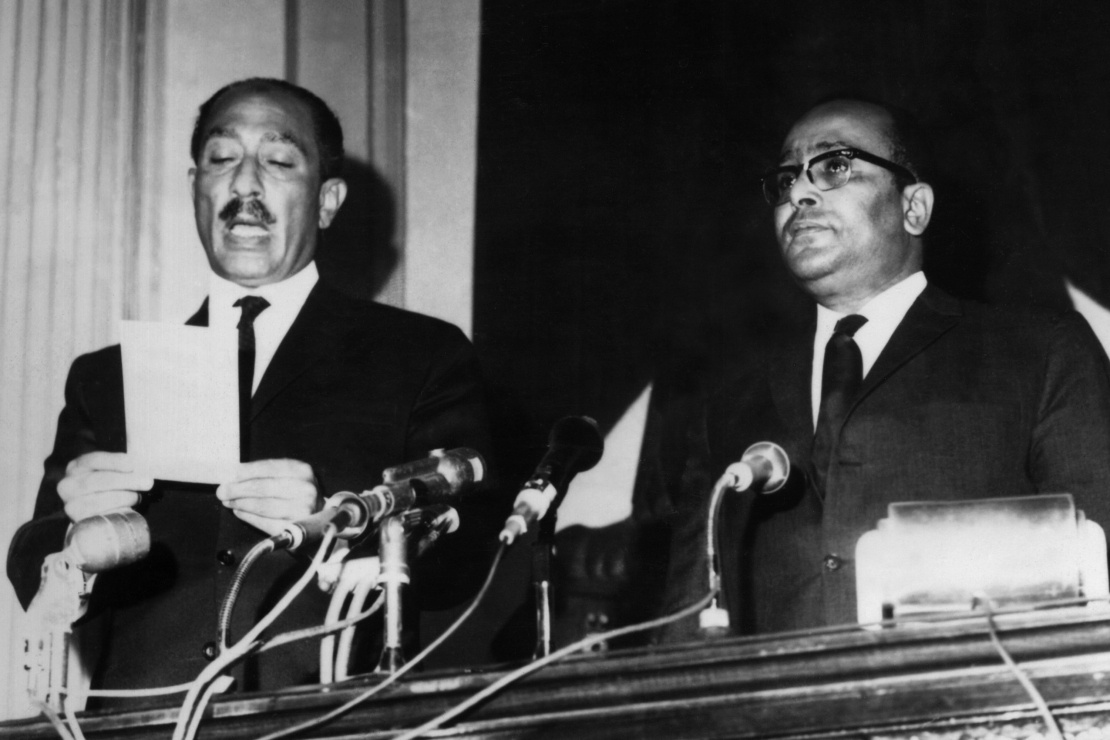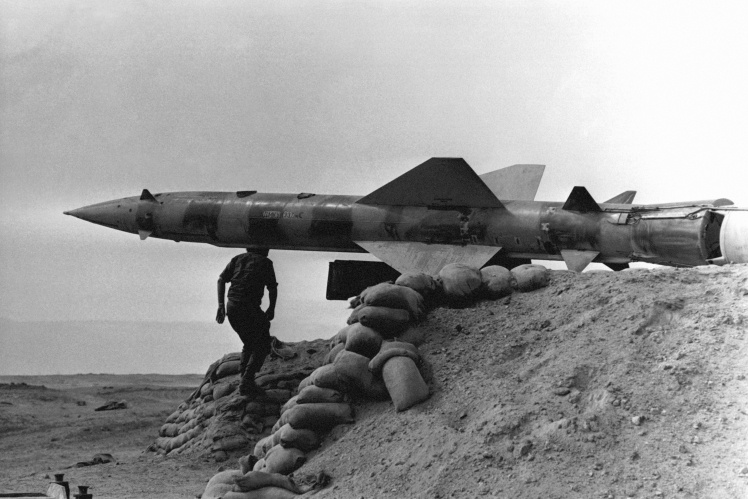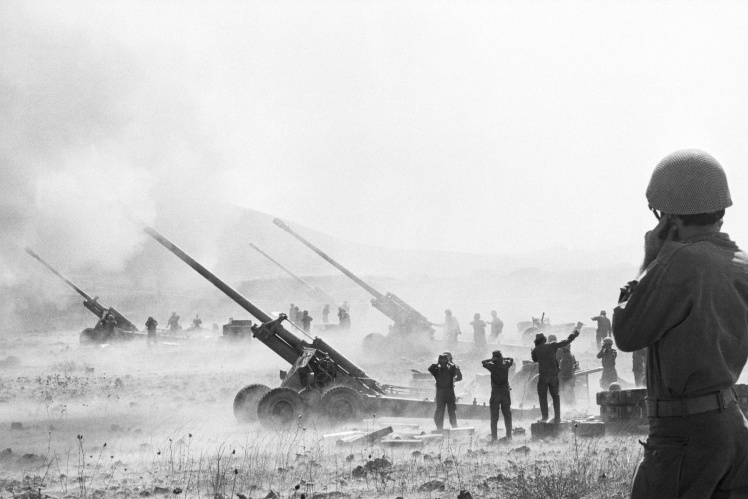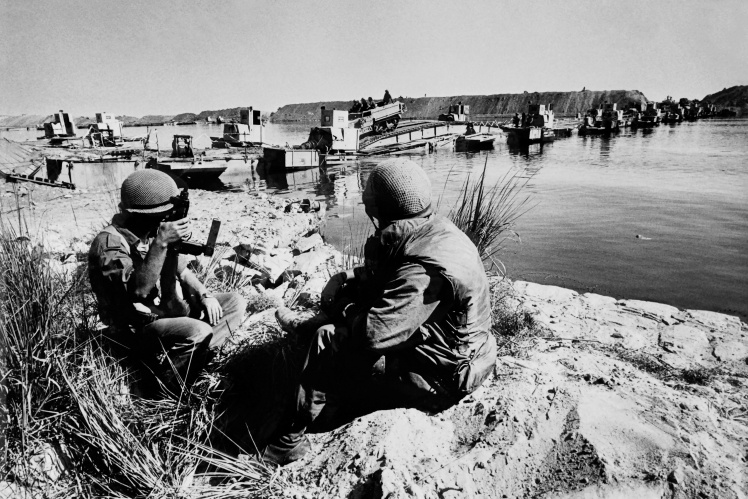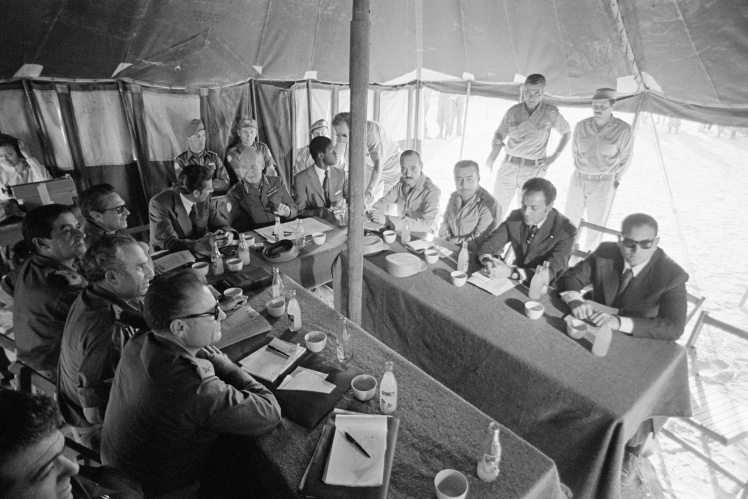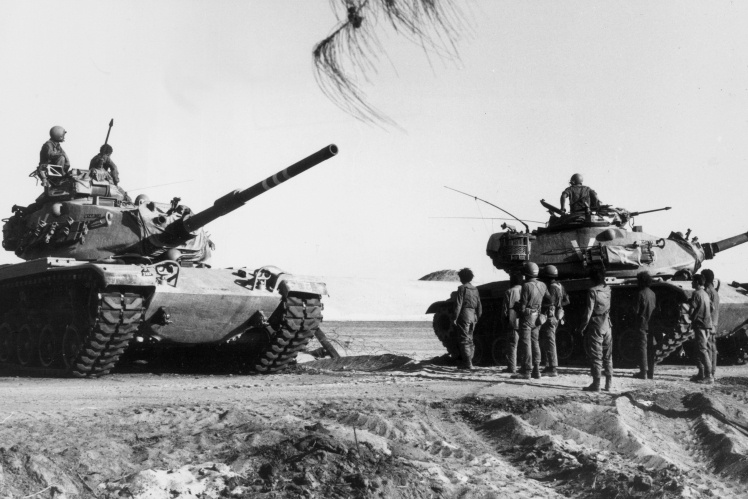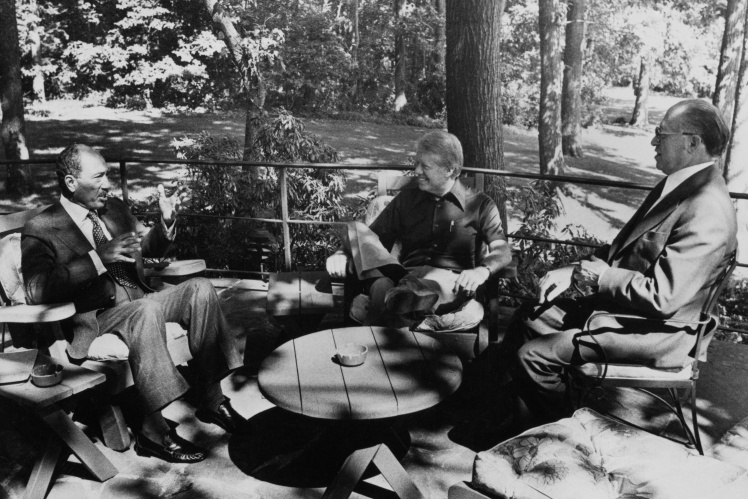In 1970, Anwar Sadat became the new president of Egypt. At that time, the country was in a deep economic crisis. But the worst thing was that the nation was disappointed by constant defeats in wars with Israel. The Six-Day War of 1967 was especially painful. Israel then captured an area almost four times its previous size. Instead, Egypt lost the Sinai Peninsula and the Gaza Strip, Syria — the Golan Heights, and Jordan — the West Bank. Not the only way out for the new Egyptian president to raise his own prestige was a new (and this time preferably victorious) war against Israel.
Anwar Sadat (left) takes the presidential oath in Cairo, October 1970.
Getty Images / «Babel'»
However, Sadat began with political steps. At first, he somewhat changed his foreign policy priorities. He sent about 20 000 Soviet military advisers out of the country and began to establish relations with Washington. And then he made an unprecedented offer — the recognition of the Israeli state in exchange for the return of the territories lost in the Six-Day War.
After lengthy discussions, the Israeli government led by Prime Minister Golda Meir rejected Sadatʼs proposal. And they could be understood — Egyptʼs offer did not provide any guarantees against the aggression of the rest of Israelʼs Arab neighbors. And they continued to adhere to the "Three Noʼs" Resolution: no peace with Israel, no recognition of Israel, no negotiations with Israel. On the other hand, this position of the Israeli government was criticized by its Western allies, especially the USA. The White House directly stated that it considers Israel responsible for rejecting "the best opportunity to achieve peace since the founding of the state."
Israeli Prime Minister Golda Meir visits a line of fortifications in the Sinai Peninsula, December 31, 1972.
Getty Images / «Babel'»
Having won political points with attempts at a "diplomatic peace settlement", Sadat began to openly prepare for a new war from the end of 1972 and negotiate with Syria about a joint attack on Israel. Despite the fact that the Egyptian president sent advisers to the USSR, he did not refuse Soviet aircraft, missiles, tanks and other weapons. Moreover, he even managed to outwit the Israeli Mossad intelligence.
From May to August 1973, the Egyptian army regularly conducted military exercises near the border in Sinai. The Mossad constantly received reports that an attack was about to happen, and the Israeli army was kept on full alert. In the end, the Israelites got tired of it, and they relaxed at all. When Egypt resumed military exercises (a week before the attack) and Syria declared the call-up of reservists, the Mossad did not perceive it as a threat. Later, the then head of the Israeli special service Zvi Zamir admitted: "We simply lost our vigilance and believed that they would not dare to attack."
Egypt shifts tanks into the Suez Canal during the Yom Kippur War, 1973.
Getty Images / «Babel'»
That year, one of the most important Jewish holidays — Yom Kippur, i.e. the Judgment Day — fell on Saturday, October 6. On the holiday, Israelites kept a strict fast, institutions and businesses, shops and restaurants were closed in the country, transport stopped, even radio and television broadcasts were limited. It was on the morning of October 6 that the Mossad reported to the countryʼs leadership that an attack was imminent. And even then, the intelligence officers were wrong about the timing of the attack. They expected that the operation would begin in the evening, but in fact the war began around 2 p.m.
Israeli headquarters in the first hours of the war on October 6, 1973. The author of the picture David Rubinger recalls that there was chaos then and no one noticed that he had photographed the secret maps. Egyptian President Anwar Sadat at the General Staff during the 1973 Yom Kippur War.
Getty Images / «Babel'»
Six hours before the attack, Israeli Prime Minister Golda Meir had to choose between two options: to hold the defense or to strike preventively, as during the Six-Day War.
"If we strike first we wonʼt get help from anybody," she said after a few secondsʼ pause.
As it turned out later, it was the right decision. Later, US Secretary of State Henry Kissinger openly said: "If Israel had struck first, it would not have received anything from us."
However, in the first days after the attack, the situation was not in favor of Israel at all. In the south, Egypt threw about 100 000 soldiers, 1 350 tanks and 2 000 guns into battle. They were opposed by approximately half a thousand soldiers of the Jerusalem Brigade and 290 Israeli tanks. The Egyptians quickly forced the Suez Canal and with minimal losses broke through the defense line, on which Israel spent half a billion dollars in 1971. Some of the fortifications, built from sand, were simply washed away by powerful water cannons.
Egyptians plant a flag during the breakthrough of Israeli fortified lines in the Sinai Peninsula, October 6, 1973.
The Israeli tank counterattack on October 8 was a complete failure. The Egyptians repelled it mainly with the help of Soviet portable anti-tank systems, which equipped the vanguard. And the Israeli aviation, which dominated the air in previous wars, proved to be powerless against the Soviet air defense missile systems.
"It was no longer the same Egyptian army that we defeated in four days in 1967. Now we were dealing with a well-trained enemy who fought skillfully and desperately," recalled one of the Israeli commanders.
In the north, the situation was no better. The Syrians advanced on the Golan Heights with 28 000 soldiers, 800 tanks and 600 artillery pieces. They were opposed by about 3 000 Israeli soldiers, 180 tanks and 80 guns. In two days, the Syrians broke through the first line of Israeli defense. It was possible to stop them at the cost of heavy losses.
An Egyptian missile in the Sinai Peninsula, October 1973. Syrian soldiers on the Golan Heights in the early days of the 1973 Yom Kippur War. Israeli artillery on the Golan Heights, 1973.
Getty Images / «Babel'»
During the first three days of the war, Israel lost about 50 planes and more than 500 tanks and was on the brick of defeat. On the morning of October 9, the Israeli leadership spoke of "approaching the point of last resort", hinting at the possibility of using tactical nuclear weapons. The hint was addressed, first of all, to the White House. On the same day, the USA decided on military supplies to Israel. The first planes with weapons arrived already on October 14. However, according to Kissinger, the key factor for this decision was not Israeli "nuclear intrigues", but Soviet intervention. Already on the second day of the war, the USSR began sending weapons to Egypt and Syria via the Mediterranean Sea. A huge fleet with submarines was used to cover the convoys. The submarines without any hints were equipped with nuclear missiles.
Israeli Prime Minister Golda Meir addresses the international community during the Yom Kippur War, 1973.
Getty Images / «Babel'»
Gradually, the situation began to turn in Israelʼs favor. Mainly it happened due to the ancient joint in the Arab countriesʼ armour — incoherence of actions. From October 9, Egypt stopped the offensive on the southern front without agreement with Syria. There was a lull in fighting there for a few days. This enabled the Israelites to transfer reserves primarily to the north. If the Syrians managed to break through the defenses on the Golan Heights, they could reach the center of Israel in a few hours. And it could be very real if the Egyptians continued to press from the south. Instead, already on October 10, Syrian troops were pushed back to the pre-war border. And over the next few days, the fighting moved to the territory of Syria. In the end, the Israelis stopped about 40 km from the capital Damascus.
Destroyed Syrian military equipment on the Golan Heights, October 17, 1973.
Getty Images / «Babel'»
All this time, Egyptian President Sadat expected the Israelites to ask for peace negotiations. Without waiting, he ordered to resume the offensive on October 14. But it was too late. Having defeated the Syrians in the north, the Israelis managed to pull up reserves to the south as well. In just one day, October 14, the Egyptians lost at least 250 tanks and about a thousand soldiers. The next day, the Israelites went on the attack. Over the next three days of fierce fighting, they pushed the Egyptians back to the shores of Suez and began to build their first pontoon bridges.
During this period, the largest tank battle since the Second World War took place, which went down in history as the "Battle of the Chinese Farm". The Israelis lost 56 tanks, and Egypt — 118.
"Iʼm not new to battles, but Iʼve never seen anything like this either in reality, or on canvas, or in the most epic war movies. It was a huge battle-field that stretched as far as the eye could see. It was a veritable valley of death," recalled the then Israeli Defense Minister Moshe Dayan.
"It seemed as if the tanks met in hand-to-hand combat. Egyptian and Israeli soldiers jumped out of them, covered in flames, and died side by side. No photo could convey all the horror that happened there," shared the impressions of the then commander of the southern front and the future prime minister of Israel Ariel Sharon.
Military equipment destroyed in the Sinai Peninsula during the 1973 Yom Kippur War.
Getty Images / «Babel'»
From October 18, the initiative finally went to the side of the Israelites. They wedged themselves between two Egyptian armies and cut off one of them from the supply routes, forced the Suez Canal with large forces and penetrated into Egyptian territory. At the initiative of the USA and the USSR, on October 22, 1973, the UN Security Council adopted a resolution obliging all parties to cease fire. But a real truce was achieved only on the third attempt — on October 25, 1973, the Yom Kippur War officially ended. By this time, the 3rd Egyptian army was completely surrounded, and the Israeli units were 100 km from Cairo.
Israeli troops cross to the Egyptian side of the Suez Canal, October 20, 1973. Representatives of Egypt and Israel discuss the agreement on the withdrawal of troops in an Israeli camp 101 km from Cairo, November 1973. Israeli tanks return to the east bank of the Suez Canal under the truce agreement with Egypt, January 1974.
Getty Images / «Babel'»
A seemingly victorious war turned into a political crisis for Israel. In February 1974, anti-government protests began in the country. The leadership was accused of being unprepared for war and, as a result, unnecessarily high losses, especially in the first days. According to the conclusions of the commission investigating the causes of military failures, several military commanders and heads of intelligence were dismissed from their positions. However, this did not save the government of Golda Meir, on April 11, 1974, she resigned in a body.
Anti-government demonstrations in Israel, February 1974.
Getty Images / «Babel'»
After the military defeat, Egyptian President Anwar Sadat returned to diplomacy. And he achieved considerable success in this. Between 1974 and 1979, he signed a series of agreements with Israel, according to which he gradually returned all the lost territories of the Sinai Peninsula in exchange for lasting peace between the countries. That is why in Egypt the Yom Kippur War is considered victorious.
"For most Egyptians, the war is remembered as an undoubted victory, both militarily and politically. The fact that at the end of the war, Israeli troops were stationed on the outskirts of Cairo, and the 3rd Egyptian army was completely surrounded, did not dampen the joyous celebration in Egypt," writes Birmingham University professor Asaf Siniver, who specializes in the history of Arab-Israeli conflicts.
In 1978, Sadat received the Nobel Peace Prize. And in three years he was killed by Islamic extremists. It happened at a military parade in Cairo on October 6, 1981, on the occasion of another anniversary of the "victorious" war against Israel.
Pictured from left to right: Egyptian President Anwar Sadat, White House Chief Jimmy Carter and Israeli Prime Minister Menachem Begin during talks at the US Presidentʼs country residence Camp David, September 1978. Attackers fire on the government tribune, where Anwar Sadat was present, during a military parade in Cairo, October 6, 1981.
Getty Images / «Babel'»
But for Syria, the Yom Kippur War became a complete disaster. A surprise Egyptian-Israeli cease-fire resulted in Israel seizing even more territory in the Golan Heights. A certain consolation for Syria was the fact that in 1979 it succeeded in expelling its yesterdayʼs ally Egypt from the League of Arab States.
So that Babel is always ready for any surprises, support us by donating: 🔸 in hryvnia, 🔸 in cryptocurrency, 🔸 Patreon, 🔸 PayPal: [email protected]
